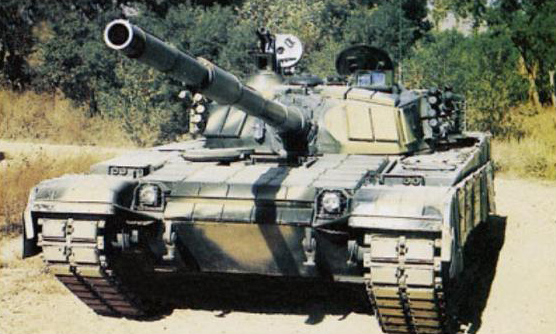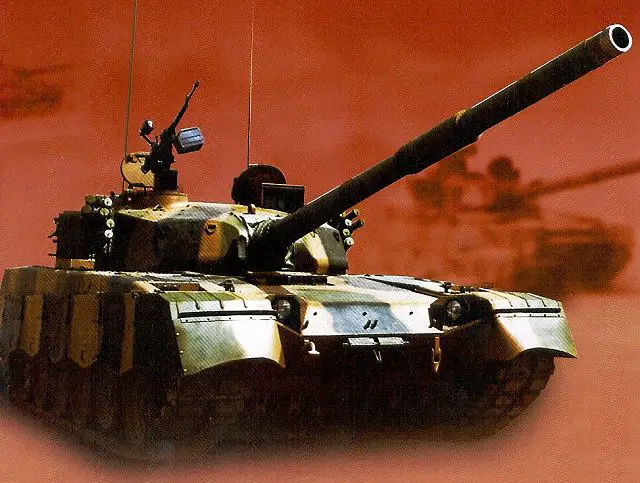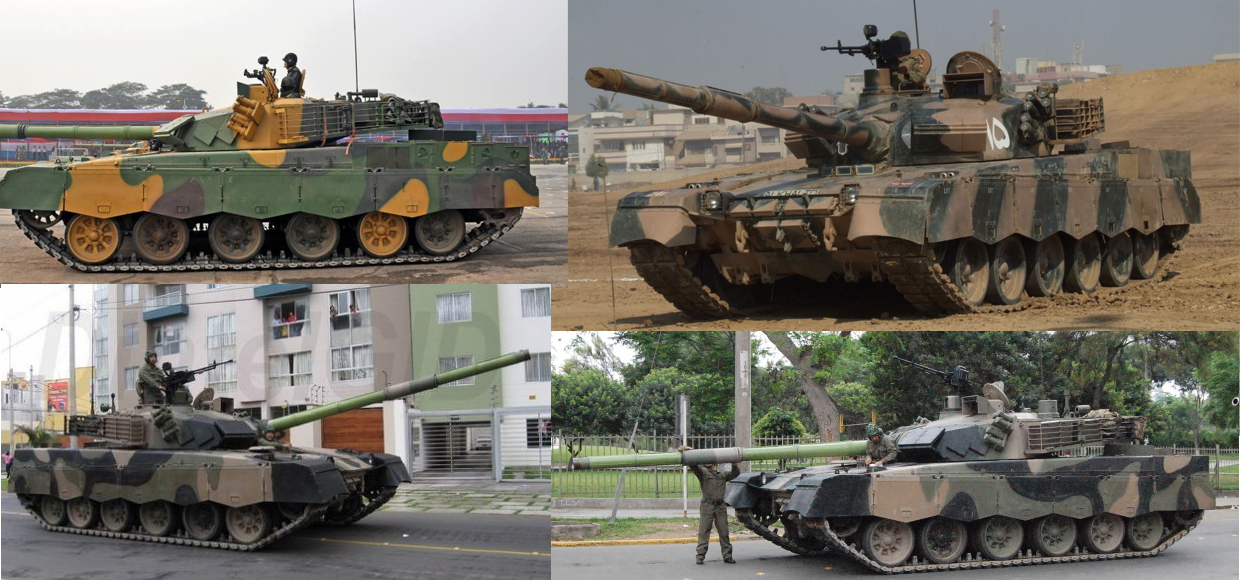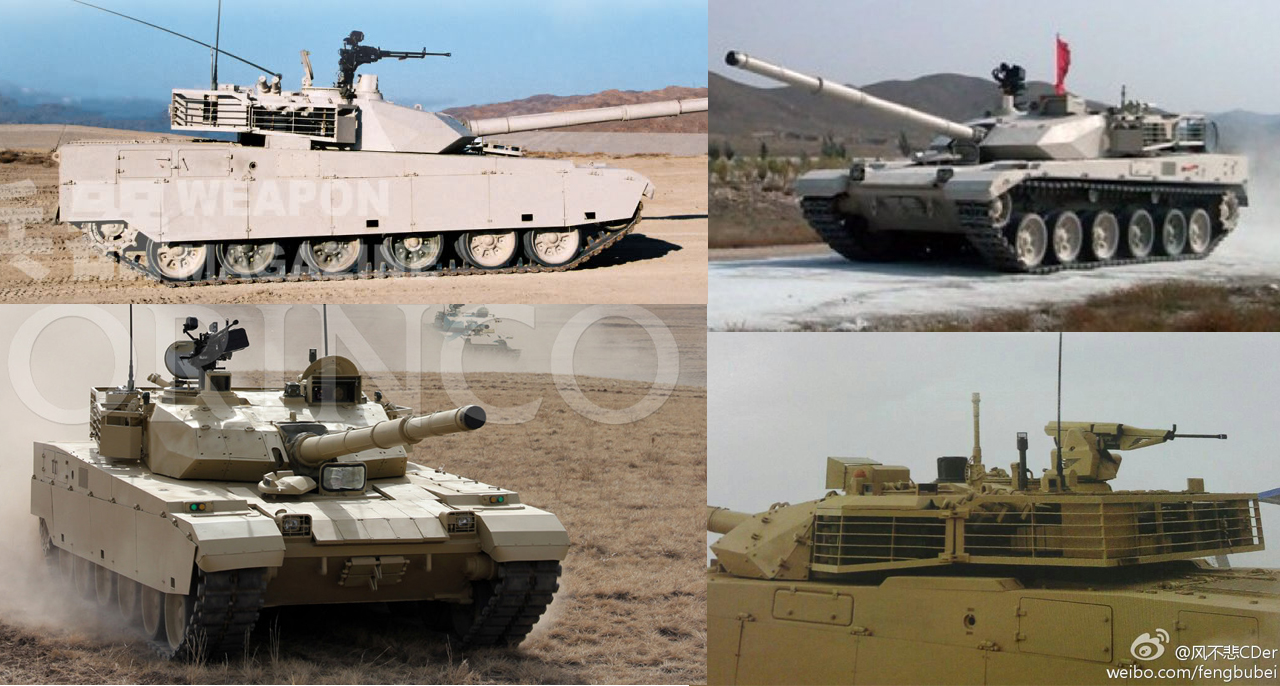The transitional Chinese main battle tank
After the Type 80/88 still using the old cast turret of the previous series and a Chinese 105 mm, plus brand new drivetrain, the Type 85 seemed the right move to catch up with the T-72, obtained by indirect sources, which was thoroughly reverse-engineered. TheGenesis of the Type 90 (1990)
The type was a separate development alongside the Type 85 by the Beijing 201 Institute (China North Vehicle Research Institute) and the Inner Mongolia 617 Factory (Inner Mongolia First Machine Group Corporation or Norinco). The great leap forward was a rethinking of armour, with the design of a fully modular set of blocks for the frontal arc of the turret. These bolted blocks allowed to be repair easily or replaced when when more advanced composite armour are available, allowing rapid armour upgrades. other than this, the powerplant was left unchanged, as well as the drivetrain, although the hull was modified to include additional ERA blocks and the side skirts were upgraded.Type 90-I
This version was developed solely for export, and intended for Pakistan that then seek for a 3rd generation MBT. In this version the engine compartment was raised and modified to allow a much bigger engine to be fitted, the British Perkins Shrewsbury CV12-1200 TCA diesel already used in the Challenger 2. It was coupled with a French SESM ESM 500 automatic transmission (Leclerc). But due to the arms embargo following the 1998 Pakistani nuclear tests the project was halted and no further progresses were made.Type 90-II
Norinco engineers capitalized on this model to create another version using a purely Chinese engine. However, the 1000 hp power plant was relatively reliable in the southern the humid climate but failed to met meet both the required army standard for northern China which is rather arid, and Pakistan's relatively comparable desert climate. In short, all the niceties of such technologically advanced engine were not yet mastered.
The Type 90-IIM
Type 90-IIM
On this prototype, China negotiated with Ukraine the delivery (since the relationships with Russia were still quite tense) of the 6TD diesel. With this engine, and even before any trials started, Pakistan was impressed enough to decide on paper to adopt this model already, named Al-Khalid. No less than 600 tanks were scheduled to be produced by the heavy industries Taxila in Pakistan until 2007 (with Norinco components), following by the MBT-2000 which is an upgraded variant. n all, Pakistan would produced some 600 Al Khalid of which at least 300 are in service with the Pakistani Army today. The design was tailored to be adaptable to multiple configurations of engine for export. Only three VT-1A (the export name of the MBT-2000) are in service with the PLAGF today for training.Design of the Type 90
Hull
The T90 hull was based on the Type 85, entirely made of welded steel RHA, with a light downards list to the rear, artificially increasing the glacis front angle and tgerefore thickness. The characteristic sides armored storage boxes were encased compartments blended into the upper hull. These storage boxes add an extra layer of protection. Overall the general configuration was just an incremental step compared to the Type 85, at least as sight was alternated with an IR sight for night driving which had around 800 m field of vision. As customary in case the upper section of the tank was blocked or it was overturned, there was an emergency extra escape hatch under his feet. The raised engine deck had six cooling grilles and engine louvres and two exhaust pipes on the right hand side, without measured to cool it or mask its heat signature.The T-90 featured a soviet-style active protection system identical to the Type 80/88/85 and comprising the usual diesel fuel injection on hot exhaust pipes to create smoke. The crew was protected inside from fire with an automatic detection and suppression fire extinguisher. Another is located in the engine compartment. Provisions is made for extra fuel tanks at the rear, rarely shown on photos. Each tank also had a generous eet of tooling inside the boxes, while an including an unditching beam is fitted at the back plate and a towing steel cable rolled around the hull. The glacis front previously fitted with a breakwater is no longer there, in order to store for ERA blocks. Day and blackout headlights had armored covers. The glacis was protected by 8 rows of 5 ERA blocks per row, with an extra 8 blocks on the lower glacis for the upgraded T-90 III.
Turret
The turret is similar in shape to the Type 85, of composite construction, octogonal while the front outer faces houses large modular amour blocks. The two other faces links with the back plate, and are fitted at the rear with two banks of smoke dischargers. Generally these are two banks of two and two of four (six in total per side). The turret large rear storage basket is doubled by BAR-style slat armour to defeat RPGs incoming in this ammo storage. The turret had fixings for the fording equipment and snorkel tube. The commander is located to the left hand side, with a peripheric cupola nearly identical to the T-85'. The gunner is seated to his right, with his own two-pieces hatch.Protection
The Type 90 uses a welded turret with a kind of modular armor. Only from the T-96 a true solution was found, using type 683 composite armour modules. The front is generally understood as using a "dolly parton" style composite armour. It is not modular, in the sense it's integral to the turret body and cannont be removed and replaced. The T-90 uses the 681 composite armour developed in China which is a sandwich of "Special material + metal + composites" sandwich-type structure.Armament
Compared to the Type 85 and 80/88, the Type 90 is fitted with the new smoothbore 125 mm cannon. This is the great innovation of this MBT. This gun comes with an auto-loader probably derived from th T-72 gun, sparing a loader and keeping the turret compact, with just the commander and gunner. The secondary armament comprised a coaxial 7.62 mm LMG (range 1,800 m range, 250 rpm) and the usual and a heavy 12.7 mm AA heavy machine gun mounted around the commander cupola. It is capable of an effective range of 2000 m. Ammo storage is split between the 2,250 7.62 mm rounds for the LMG and 500 rounds for the 12.7 mm HMG. Characteristics of the auto-loader is foggy but t was thoroughly tested tested on the Type 88 and the Type 85 until the Type-85-III make it very reliable. It was just scaled up and adapted for the Type-90. Its operating comprises complete ramming, filling of the rounds with separate charges. Maximal rate of Fire is rated to six round a minute and the larger smoothbore gun allows a wide range of ammunition, all compatible with Russian T-72 stocks. It comprises the HEAT, HE, APFSDS, and ATGMs. The normal provision is circa 42 rounds. The gun mount allows a - 4° depression and + 12° elevation.APFSDS: Muzzle velocity 1,730 m/s, armour penetration 500 mm RHA at 0° at 2,000 m. This is a 546.5 mm long, 7.34 kg in weight round, compatible with the T-72 tank gun according to NORINCO.
BK-27 HEAT: Triple-shape charge warhead, penetration value 600 mm of RHA at 0° at 2000 m
BK-29 HEAT: Triple charge, hard penetrator cap either tungsten or depleted uranium, tailored for dealing with reactive armour. Penetration value 550 mm of RHA at 0° at 2000 m.
Mobility
The Type 90 relied on the same modern drive train developed on the previous Type 80/85/88. It comprised six lightweight doubled road wheels suspended on their own independent torsion arm. Additional shock absorbers were placed at the front front (two per side) and one set either side at the rear. Basically the drive spocket, idler, return rollers and tracks were shared between all these for standardization. The whole drive train could be protected by rubber skirts, with six panels to defeat RPGs, but practice they are rarely shown mounted on the Type 90.The type 90 poerplan was the 12150ZL type V-12 cylinder water-cooled turbocharged diesel engine rated for 537 kilowatts (730 hp) at 2200 rpm. This power unit is derived from late 1980s Western (German) designs but no technical improvement was available when the wet put a ban on technology transfers after 1989. The Type 96 series could have been upgraded with the Domestic 85-III experimental 1,000 horsepower diesel but the latter was conceived for the export of foreign trade market and did not corresponds to Chinese PLA own specifications based on a wide range of climatic diversity.
According to official data, the standard Chinese 12150ZL turbocharged diesel was developed from 1973, tested in 1974, and went through 13 incremtntal evolutions. From 1987, after 17 years of service with the Type 80, the engine was considered rugged and reliable, with ease of maintenance, a main factor in PLA's doctrine. This engine was basicaly a reversed-engineered Soviet B2 already present on the T-54A, adapted to the Type 59, and whihch reached its maximum possible technical evolution. Commonality with the new powerplant was a great advantage for logistic and maintenance, assured to provide a lot of spare parts. The Type 90 12150ZL-6 diesel was therefore a good choice for keeping mechanics skilled on five different types of tanks in service with the PLC. It was also quite cheap on the long run, and served the type 85 well, and the Type 96 with the version 7.
However the heavier type 96G showed this engine could not be sufficient anymore. The Type 90's top speed was 70 kph, and the tank was capable of climbing a 60% gradient, 40% side slope without drifting, climb a vertical step 0.8 m, crossing a 2.7 m trench or ford 1.4 m of water and 5 meters with preparation. However, since the Type 90 was to be an export tank, the final Type 90-II prototypes used either a more modern MTU diesel, British perkins or Ukrainian diesel and/or German or French transmission while the IIM is given a powerful Ukrainian power unit.
Mobility
Compared to the Type 85, the Type 90 weighted more, and accused a slight loss in mobility. This was even worse on the Type 96, until the G version appeared with a brand new 1,000 hp engine, which allowed to regain all the lost mobility since the Type 59, and having much better performances. In fact, the Type 96G is even the de facto Chinese PRC champion in any tanks bihatlon. However all these tanks suffers from steering mechanism planetary gearbox reliability.Development tree
The Type 90 development is largely experimental but spawned no less that five main production models, mostly aimed at export: The Type 90-II, a further development of the Type 80/85 introduced in 1992 was presented as a new production tank, but was only leading to a long serie of prototypes aimed at export. Therefore the "Type 90", and "Type 90-I" does not exist and any ZTZ designation has been given as the type has been refused for production bt its development went on in the 1990s in parrarel to the Type 96 purely for export. Outside the prototypes, production amounted to around 550 tanks between Pakistan (MBT-2000/Al Khalid), Bangladesh (VT-1) and other customers.Type 85-IIM prototype (1991)
Type 90-II prototypes (1992-94)
P1 Prototype: Chinese 125 mm gun, autoloader, FCS, German MTU-396 diesel, Renk LSG-3000 transmission.P2 Prototype: Same but Western fire-control, Perkins 1200 hp Condor diesel engine, French SESM ESM500 automatic transmission.
P3 Prototype: Same but Ukrainian KMDB 6TD-2 1200 hp diesel/French SESM transmission.
P4 Prototype: Export variant with a German NATO 120 mm gun, Western FCS, MTU-871 diesel/Renk LSG-3000 transmission.
-VT-1A 2002 Export variant of the Type 90II: All-Chinese interior, turret and gun, electronics and armour and the new 1300 hp powerpack and transmission. purchased by Bangladesh and Morocco, Myanmar and Sri Lanka
Type 90-IIA Export prototype: French 1 500 hp diesel, cancelled after the French 1998 embargo. Another variant with an Ukrainian powerpack for Peru was also cancelled, due to Ukraine's refusal to provide the engine.
Production variants
Chinese 90-IIM (marketed as MBT-2000):Introduced in 2000, using basically the IIP3 as a base. It was powered by the Ukrainian KMDB 1,200 hp 6TD-2 diesel engine (for 46 tonnes, 72 km/h). The MBT-2000 was first presented to the public in 2001 Abu Dhabi defence exhibition.
From there was developed the Pakistani Al-Khalid operational in 2001.
-Al-Khalid I carried more rounds, had a better FCS and computer, with a 7 km identification range and better engagement range, plus digital driver panel, IBMS and more modern side-skirts and track pads, modernized auto-loader and bigger carousel for longer rounds (9 rounds per minute) and an Ukrainian Varta electro-optical jammer, plus the gunner and Cdr. Sagem thermal imagers, better air conditioning system.
-Al-Khalid II (In development 2019-2021) Redesigned turret, upgraded modular armour package, sensors, new 1500 hp powerpack.
-VT-4: In development since 2009 as MBT-3000, production started in 2017. Customers: Thailand, Nigeria, Pakistan;
Links on the Type 90
The Al-KhalidOn army-recoignition
On army-guide
On FAS.org
The Type 90-II on military-today.com
Type 96 on armyrecoignition.com
The Type Al Khalid on wikipedia.

Type 85 For comparison.

Type 90-II P1 in tests.

Type 90-IIM in tests.

Type 90-II in tests (src: globalsecurity.org)

Type 90-II in tests (src: globalsecurity.org)

Type 90-II in tests (src: globalsecurity.org)

Type 90-II in tests (src: military-today.com)

Type 90-II/MBT-2000 (src: armyrecoignition.com)

MBT-2000 (src: here)

VT-1A (src: here)

Modern Tanks
Modern MBTs posters

Denel Bagder (2018)

Type 16 MCV (2016)

Gepard 1A2 last rounds 2011

SANDF

Russian AFVs

Main Battle Tanks

